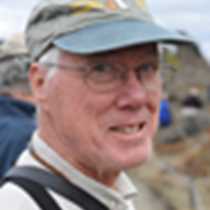Krossfjord, Spitsbergen, Svalbard
Krossfjord is the northern arm of a large fjord complex in northwestern Spitsbergen, and here we came to spend the last day of our voyage around the Svalbard Archipelago. At the head of Krossfjord is the massive Lilliehookbreen Glacier, which carries ice down from the mountains to the north into the water of the fjord. For this, our finale, we offered it all: a long hike over the tundra to reach the remnants of a World War II German weather station; kayaking in supreme tranquility among chunks of blue ice calved from the glacier face; and cruising by Zodiac in search of wildlife and the perfect ice photograph.
Above us loomed a massif of metamorphic rock, decorated with splashes of white, orange, and green. All of these bear evidence of colonies of breeding seabirds. The white – guano; the orange – elegant jewel lichen that frequently adorns rocks that are frequented by birds; and the green – lush plant growth, taking advantage of the input of nutrients carried from sea to land by returning birds. A simple trick – cupping our hands behind our ears while facing the cliffs – amplified the avian chorus of kittiwakes and thick-billed murres nesting above us.
A pair of glaucous gulls nested low over the water, their three downy, gray chicks nourished by the taxes that their parents collect from the colony above. Comical Atlantic puffins floated quietly on the water, allowing the close-up photograph that we had so wanted.
Where there is a seabird nesting colony on Svalbard there are usually Arctic foxes. During winter, the foxes follow polar bears on the sea ice to scavenge the remains of their kills. During summer, when the foxes must attend to a den full of hungry kits, they frequent bird colonies. We eagerly scanned the slope, hoping for a view, and we were rewarded for our effort. Five kits, now nearly full grown, scampered and chased over the upper slope. Their mottled, brown and tan fur blended into the background, making them difficult to spot at this distance.
One thing we have learned about the Arctic sea ice is its changeability, as it moves with winds and currents. Fortunately, we receive updated ice charts daily. Although the west coast of Spitsbergen, warmed by the last arm of the north-flowing Gulf Stream, is usually ice-free, the latest ice chart shows a mass of sea ice gathered near the entrance to Isbukta, our final destination. Discretion ruled, and the National Geographic Explorer turned her bow toward Isbukta and Svalbard's capital city of Longyearbyen. Along the way, one final natural history moment: walrus lounging on the sea ice.



